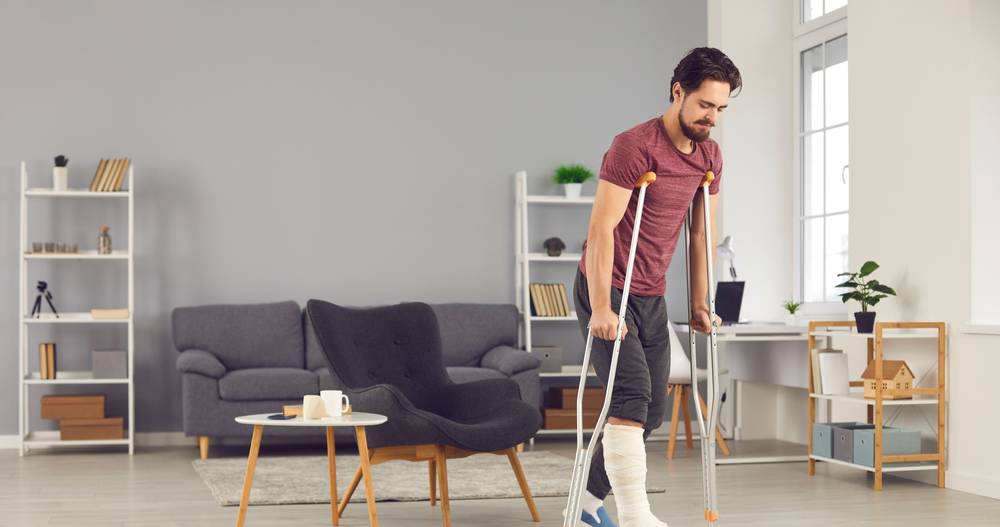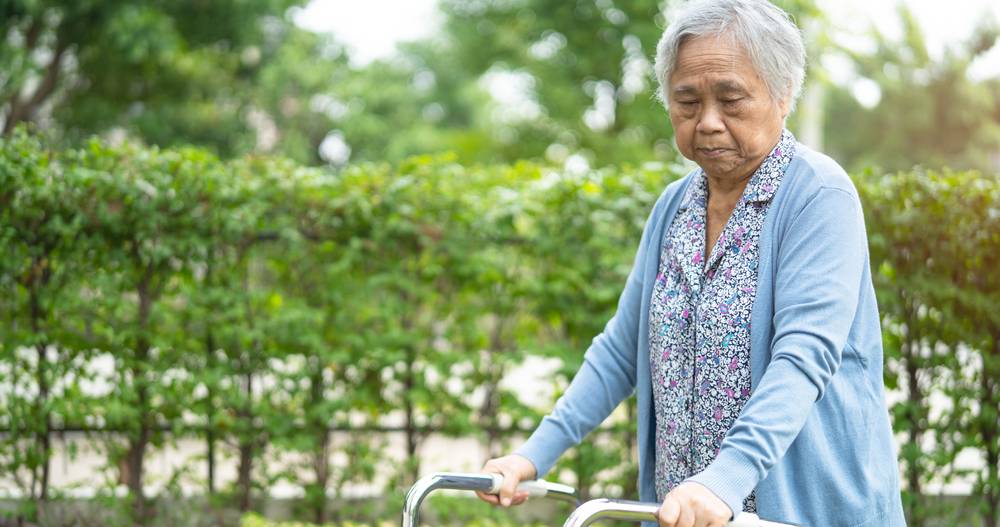Have you ever tripped and hurt your ankle, needed a cast on your leg, or suffered a stroke and weakness in your legs? If you have had any injury to the lower half of your body, you may be familiar with crutches, canes, or even a walker.
If you have orthopedic surgery on your lower body, you will, at some point, use a mobility device. These will be utilized to promote optimal healing by keeping your weight off the surgery site. Our physical therapists at AICA College Park can help you learn how to navigate with your prescribed mobility device and help you to strengthen your body as you heal.
These assistive devices are used to shift weight off of the injured limb and provide stability during the healing process. While helpful, these devices can be frustrating to learn at first. Below are some tips and tricks to make using crutches, canes, and walkers easier and safer.
Make Your Home Safer
To help with adjusting to a mobility assistive device, it might be helpful to ensure your home is safe to navigate. By keeping your home free of obstacles and trip hazards, you are also lessening your risk for slips, falls, and other injuries.
- Clear walkways of clutter, trash, and throw rugs
- Tuck electrical cables out of the way to avoid tripping
- All walkways and rooms should be well lit and nightlights utilized at night.
- In the bathroom, utilize grab bars and anti-slip mats
Crutches
 Crutches are a useful mobility aid when you need to keep your entire body weight off of a lower extremity like your foot, ankle, knee, or entire leg. A fractured tibia, sprained ankle, or after having surgery to repair a torn ACL, crutches will be very useful! Used when walking upright, crutches require balance, two hands, and at least a bit of coordination to utilize. If you aren’t sure if crutches are the right tool to use, contact us at AICA College Park to schedule an evaluation of your injury today.
Crutches are a useful mobility aid when you need to keep your entire body weight off of a lower extremity like your foot, ankle, knee, or entire leg. A fractured tibia, sprained ankle, or after having surgery to repair a torn ACL, crutches will be very useful! Used when walking upright, crutches require balance, two hands, and at least a bit of coordination to utilize. If you aren’t sure if crutches are the right tool to use, contact us at AICA College Park to schedule an evaluation of your injury today.
Proper Measurement and Positioning
- Each crutch should sit approximately 1.5-2 inches below your armpits
- The handrails should line up with the top of your hip
- When using, your elbows should be slightly bent
- Do not rest all your weight on your armpit; most should be transferred into your forearms and hands
How to Sit Using Crutches
Sitting is semi-difficult with crutches and requires a decent amount of strength in your good leg.
- You want to back up to a sturdy chair and put your weight on your good leg
- Transfer both crutches into one hand
- Use your free hand to support your weight as you lower yourself into the chair
- Store your crutches in easy reach
Walking with Crutches
Walking with crutches is easy enough once you get the coordination down, but you should still be careful.
- Lean forward slightly.
- Move both crutches forward at the same time- approximately a foot in front of you.
- While resting your weight on your good foot, shift your bad foot forward.
- Instead of putting that foot down, transfer your weight to the crutches.
- Push off with your good foot and bring it forward as if completing a normal step.
Navigating Steps with Crutches
Going up and down steps might be the hardest and most precarious movement to do while using crutches. Walking up and down the stairs with crutches requires a significant amount of strength and flexibility. For safety reasons, it would be beneficial to have a second person to help you, at least for the first several times.
- Hold the handrail with one hand and your crutches with the other.
- Lead with your good leg and take one step at a time.
- Your crutches should be held on the side with your bad leg.
- In order to go down the steps, reverse these steps, except you will lead with your bad leg and crutch.
- You will have to lean forward pretty far, so be very careful.
If you are not strong or coordinated enough or even if you just feel safer, you can sit down and slide down each step on your buttocks. Sit on the step and use your arms for support to push yourself up each step backward.
Canes
 You will find canes to be much easier than crutches, but they serve a vastly different purpose. While crutches are designed to take the full weight of your body, a can is a supportive/assistive device only. A cane can be used as a walking aid for hip pain, the next step after graduating from crutches, and as a support when you struggle with balance. Canes are lightweight and less cumbersome than crutches. You might think of canes as something older people use, but anyone that has balance or stability issues can benefit.
You will find canes to be much easier than crutches, but they serve a vastly different purpose. While crutches are designed to take the full weight of your body, a can is a supportive/assistive device only. A cane can be used as a walking aid for hip pain, the next step after graduating from crutches, and as a support when you struggle with balance. Canes are lightweight and less cumbersome than crutches. You might think of canes as something older people use, but anyone that has balance or stability issues can benefit.
Proper Measurement and Positioning
Holding your arms loose at your side, the handle of your cane needs to fall at your wrist with a slight bend in your elbow. You might find it better to have a custom cane or an adjustable height cane, depending on your needs. Not every type of cane will work for every person.
Sitting with Your Cane
Similarly to when using crutches, use one hand to balance on a sturdy chair and slowly sit down, storing your can within arms reach.
Walking with Your Cane
Unlike crutches, a cane should be on the opposite side from your injury or weak extremity.
- Rest your weight on your good leg
- Step forward with your bad leg and cane at the same time
- The goal is for the cane to balance any weakness in the bad leg
- Complete your stride with your good leg
Using Your Cane to Navigate Steps
It is important to be careful while climbing stairs, but with proper technique, your cane can actually help you ascend more safely!
Going up steps:
- Grasp the handrail on your weaker/injured side.
- Step up on your good leg first.
- With a firm grip, push up with your weight distributed between your cane and the weaker/injured leg.
- Finish your step.
Going down steps:
- Put your cane on the step first.
- Then put your injured leg down, resting most of your weight on your good leg.
- Shift your weight to the cane and weaker/injured leg.
- Bring your good leg down to meet the other.
Walkers
 Walkers are a great option in between crutches and canes. There are several types that can be used for a variety of mobility needs. Walkers are designed to keep some or all of your weight off your lower body. Rollators, a type of walker, have a seat that allows the user to sit when necessary to take all weight off their lower extremities. The two types of walkers most commonly used are:
Walkers are a great option in between crutches and canes. There are several types that can be used for a variety of mobility needs. Walkers are designed to keep some or all of your weight off your lower body. Rollators, a type of walker, have a seat that allows the user to sit when necessary to take all weight off their lower extremities. The two types of walkers most commonly used are:
- Rollators- a walker with 2 wheels, 2 stationary legs, brakes, and a seat
- Standard- a walker with 4 rubber-tipped legs, usually foldable
Commonly used after hip replacement surgery or hip injury. It is common to see people with gait instability use them as well. They are four-legged and are very stable. Rollators have wheels on them which can aid in ease of movement. Make sure you check the feet and wheels of your walker regularly. Any defects or wearing should be addressed immediately to maintain structural integrity.
The Proper Positioning of a Walker
- As previously mentioned with canes, the top of the walker should be in line with your wrist, and your elbows should be slightly bent.
- The most important thing is your posture- do NOT hunch over your walker.
○ Hunching can cause back pain and worsen any pain associated with your injury or surgery site.
Walking with Your Walker
- Place your walker in front of you, about one step ahead. All four legs should be on the ground.
- Grip both sides of the walker firmly and step slightly into the walker, not all the way to the front.
- Lift and move your walker a step forward and step into it again.
- If you are injured on one side, you want to lead with the walker, then the injured leg, and supporting yourself on the walker, bring your good leg forward to meet the other.
- Take small steps and turn slowly if needed.
Do NOT use steps with your walker. When you need to sit, sit as you would with crutches or a cane, but you can keep both hands on the walker when lowering yourself into a sturdy chair.
Contact AICA College Park Today!
AICA Orthopedics staff are experts in their field. Our goal is to treat your pain or injury with a comprehensive plan. Whether you need a mobility aid due to surgery or injury, our team is here to help. Our doctors and physical therapists will help you determine the right aide to assist you and guide you through the healing process. If you need crutches, a cane, or a walker long-term, our team will help you navigate the world with ease!